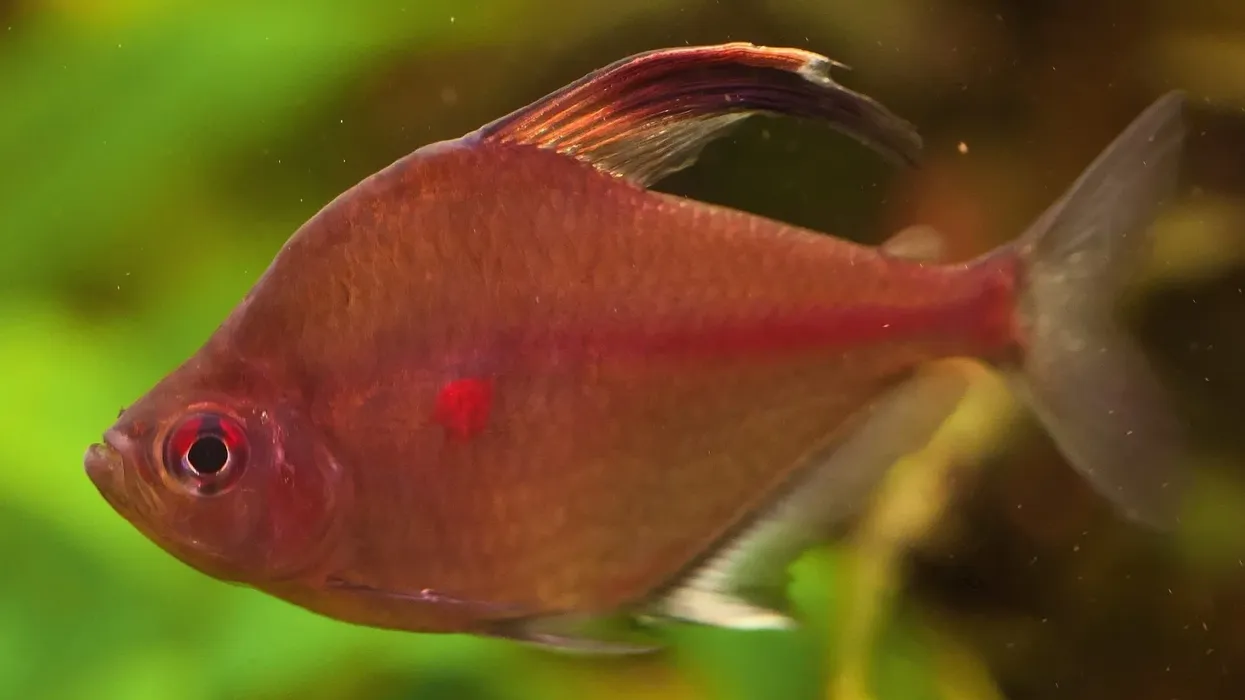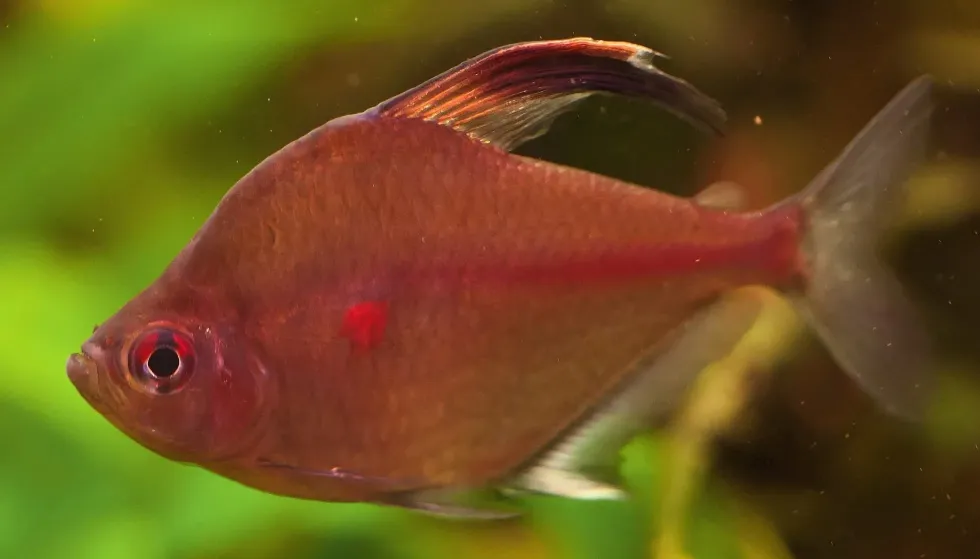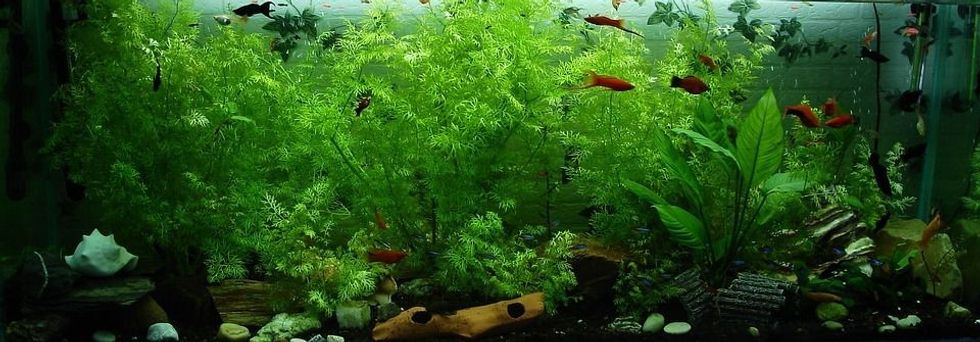A Hyphessobrycon erythrostigma or heart tetra fish is one of the most common species of tetra fish that are also found in pet shops. They are known to be community fish and live in pairs of four to six or more even and are not that difficult to maintain.
Bleeding heart tetras are often kept with other peaceful tetras in the same tank or aquarium. Under captive conditions, they act as good tank mates for other peaceful tetra fish species. The male has a longer dorsal and anal fin than the female.
To find out more interesting facts and information about this fish, read on. You can also check our guides on the sand shiner and the ruffe for more enriching and mind-blowing facts and guides.
Bleeding Heart Tetra Interesting Facts
What type of animal is a bleeding heart tetra?
The bleeding hearted tetra or Hyphessobrycon erythrostigma is a freshwater tropical fish species found natively in the Amazon basin. It's a peaceful fish species that can live under moderate water temperature and are quite amicable in behavior.
What class of animal does a bleeding heart tetra belong to?
The bleeding hearted tetra fish belongs to the Actinopterygii class. The members of this particular class include all the ray-finned and bony fishes.
How many bleeding heart tetras are there in the world?
We do not know the exact population of bleeding tetra fish. However, as they are schooling fish kept in groups of four or five, they tend to get aggressive and cause fin nipping, and in some cases, they can even die.
Thus, they are available in quite a huge number in the wild and under captive conditions like fish schools, aquariums, and tanks.
Where does a bleeding heart tetra live?
Bleeding heart tetras fish are freshwater fishes and can be found in wild tropical freshwater areas of South America, Columbia, and natively in the upper side of the Amazon basin. They are one of the most popular species of school fish and are easy to keep under proper aquatic conditions.
Thus, you can find them in any school for fish all around the world. Bleeding heart tetra care is quite moderate in terms of difficulty.
What is a bleeding heart tetra's habitat?
Under wild conditions, bleeding heart tetras are found under slow-moving tributaries of streams of the Amazon basin and the shade of canopies. They are known as tropical fish.
The tetra (bleeding heart) is quite peaceful in terms of behavior. They generally prefer the midsection of the water that is not too deep nor too shallow.
In the natural habitat, they like to keep themselves surrounded by plants, branches, and other freshwater vegetative plants' roots. The substrate is sandy, and the water is not hardy.
They live in a group and are known as schooling fish, and can easily be kept under captive conditions in an aquarium or a tank.
Under captive conditions in an aquarium or tank, they require a moderate level of care and are highly adaptive. With proper water temperature and feeding habits, bleeding heart tetra care is not tough.
Breeding them in captivity – like an aquarium or a community tank – is also not that hard. Their tank mates should be peaceful, or if possible other tetra fish can be the best tank mates for them.
They should be kept in a minimum of 20 gal (76 l) tank with proper water temperature for proper breeding. The water should not be hardy in the tank or aquarium.
Who does bleeding heart tetra live with?
Bleeding heart tetras are schooling fish – be it in the wild or in captivity like a tank or an aquarium. They live in a group or in pairs of four or six in a community tank or an aquarium.
The bleeding heart tetra is a peaceful tropical fish and is social, be it in a tank or an aquarium. Keeping them isolated and alone can result in them fin nipping or even being aggressive towards their tank mates.
Bleeding heart tetras can get stressed if kept alone in a tank or an aquarium.
As the bleeding heart tetra is a peaceful fish, so its tank mates should also be peaceful. It is recommended to keep them with other species of tetra fish as all the tetras have similar breeding, feeding patterns, and requirements, more or less.
How long does a bleeding heart tetra live?
The bleeding heart tetras are a species of school fish that can live in the wild and in captive conditions like a tank or an aquarium. The average lifespan of bleeding heart tetras is between 8-10 years.
If kept under captivity with proper temperature, 20 gal (76 l) water tank, and proper substrate level, then they can live up to 10 or a few more years in some cases where proper breeding and feeding facility is available for the fish.
How do they reproduce?
The breeding part in the bleeding heart tetra care routine for this fish can be difficult to deal with, but this isn't impossible and can be done under proper water conditions in a community tank or aquarium. The female fish often ignore the male fish if kept in the same tank.
Thus, a separate breeding tank is placed so that both male and female bleeding heart tetra fish can breed properly. Either you should pick the best pair or let the female fish decide accordingly.
For proper mating, a 20 gal tank (76 l) is important.
A female's belly becomes big and nicely rounded when she has lots of eggs. The tank should not have hardy water, and different plants should be there in the tank so that the females can lay eggs properly as the females need a proper place to lay their eggs.
After the females lay the egg, you should keep the tank or aquarium quite dim as the eggs cannot tolerate much light. The water must be soft and with a proper acidic level.
Males and females should both be removed from the tank when the eggs settle at the bottom, or they might eat their eggs.
Eggs generally hatch within two to three days. In three to four days, they start swimming.
In the initial days, the fry must be fed with infusoria-type foods. The diet of the fry is important for their survival and lifespan.
What is their conservation status?
They don't fall under any conservation list, and hence the bleeding heart tetras fish fall under the Not Evaluated category of the IUCN list.
Bleeding Heart Tetra Fun Facts
What does bleeding heart tetra look like?
The bleeding heart fish can be distinguished from other fish as they have a unique blotch of blood-red color on their side pectoral fin that resembles the look of a heart. The color scale of this fish can range from beige-orange to silvery lavender.
The scales can turn into a metallic gold color that a parasitic infestation can cause. The dorsal fin of the males of the bleeding hearts is long.
The males in bleeding hearts have longer and extended dorsal and anal fins than the anal fins of the female. A female bleeding heart is more full-bodied than a male.
They show their full colors when they feel secure between plants and shades. The body of both shows different features and colors.
How cute are they?
They have a cute heart-shaped red spot bloat on their fins that look pretty, and they show a certain range of colors. Thus, you can find them to be peaceful and cute.
How do they communicate?
They are known to be shy and peaceful under natural conditions. However, since they communicate like any other fish, they also communicate through body movements and behaviors. If they are upset, they usually hide or show aggressive behavior or fin nipping.
How big is a bleeding heart tetra?
The average length of the bleeding heart fish can be up to 3 in (8 cm). The females are more full-bodied than the male fish and have shorter rounded fins. Other species of tetra are small in size as well. For instance, the black phantom tetra measures 1-1.4 in (2.5-3.6 cm) in length.
How fast can a bleeding heart tetra swim?
They can swim quite fast and are known to be good midsection swimmers in natural freshwater habitats. However, their exact speed is unknown.
How much does a bleeding heart tetra weigh?
There is no accurate data available about the range of weight of the bleeding heart tetra fish. However, a flame tetra weighs about 0.004 oz (0.11 g).
What are the male and female names of the species?
There is no such specific terminology of a male and a female heart tetra bleeding fish.
What would you call a baby bleeding heart tetra?
A baby heart tetra bleeding fish is known as a fry or fishling.
What do they eat?
The baby fish are kept in separate tanks when they hatch from their eggs, and their diet consists of small live food, infusoria-type foods, freeze-dried food, and flake food. The adult ones can also have freeze-dried food, live food, flake food.
Their diet should also contain brine shrimp, micro pellet foods, vegetative material. Different other varieties of foods can also be included in their diet if they are living in community aquariums and tanks.
Are they poisonous?
No, they are not all poisonous. They are nice and should be kept in groups in an aquarium.
Would they make a good pet?
Yes, they make good pets as they are highly adaptive and require only 20 gal (76 l) of water with some plants and vegetation around to breed properly. You can search them around any fish shop in a proper gallon tank.
Did you know...
It is unlikely for a tetra species to breed with another tetra species. However, there are instances of crossbreeding into a mix tetra.
Candy cane tetra fishes can live up to three to five years of age in captivity.
Are bleeding heart tetras fin nippers?
Some boisterous individuals can be fin nippers if they are kept alone and not in groups. They might get aggressive on other tank mates as they are community fish.
What pet fish lives the longest?
Some species of common goldfish, koi, discus, can live up to 50 years or 70 years or even more. Some shark fish can live over 100 years or even more. For example, the Koi carp named Hanako fish that lived in a pond in Japan, Mount Ontakein in Gifu, lived up to 226!
Here at Kidadl, we have carefully created lots of interesting family-friendly animal facts for everyone to discover! Learn more about some other fish from our whiting facts and fusilier fish facts pages.
You can even occupy yourself at home by coloring in one of our free printable bleeding heart tetra coloring pages.










